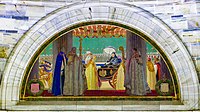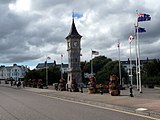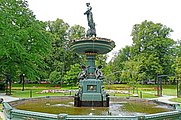| Diamond Jubilee of Queen Victoria | |
|---|---|
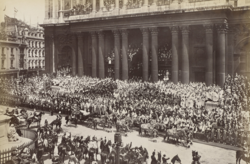 Arrival of the Queen's carriage at St Paul's Cathedral to attend the Diamond Jubilee Service | |
| Genre | Jubilee of British monarch |
| Date(s) | 20 June 1897 |
| Country | |
| Previous event | Golden Jubilee of Queen Victoria |
| Next event | Silver Jubilee of George V |
The Diamond Jubilee of Queen Victoria was officially celebrated on 22 June 1897 to mark the occasion of the 60th anniversary of Queen Victoria's accession on 20 June 1837. Queen Victoria was the first British monarch ever to celebrate a Diamond Jubilee.
Background
Queen Victoria surpassed her grandfather King George III as the longest-reigning British monarch on 23 September 1896, an event that she marked privately at Balmoral Castle. She wrote in her journal, "People wished to make all sorts of demonstrations, which I asked them not to do until I had completed the sixty years next June." The Diamond Jubilee was therefore an opportunity to celebrate Victoria's status as the longest-reigning monarch, in addition to marking 60 years on the throne. [1] On 20 June 1897, the sixtieth anniversary of her accession, Victoria wrote in her journal: [2]
This eventful day, 1897 has opened, and I pray God to help and protect me as He has hitherto done these sixty long eventful years! I feel sad at the new losses I have sustained, especially the last one of our beloved Liko! God will surely help me on! How well I remember this day sixty years ago when I was called from my bed by dear Mama to receive the news of my accession!
The sixtieth anniversary of her accession was celebrated on 20 June 1897 with a thanksgiving service at St George's Chapel, Windsor Castle. [1]
Celebrations
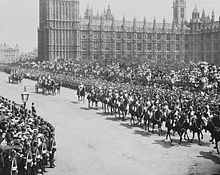
The occasion was marked publicly two days later by the Festival of the British Empire proposed by Joseph Chamberlain, who promoted the idea of a global celebration fit for a monarch ruling over 450 million people. [3] The day was declared a bank holiday in Britain, Ireland and India. The British Army and Royal Navy as well as troops from Canada, India, Africa and the South Pacific took part in the procession in London. [3] The Queen telegraphed a message to all nations in the British Empire: "From my heart I thank my beloved people. May God bless them." [2]
At 11:15 am, the Queen, along with Princess Helena and the Princess of Wales, took part in the parade in an open carriage from Buckingham Palace to St Paul's Cathedral, where thanksgiving service took place. [4] Seventeen other carriages carrying members of the royal family followed her. [4] Eleven colonial prime ministers were in attendance: [5] [6]
-
 The Prime Minister of Canada and
Lady Laurier
The Prime Minister of Canada and
Lady Laurier -
 The Premier of New South Wales
The Premier of New South Wales -
 The Premier of Victoria and Lady Turner
The Premier of Victoria and Lady Turner -
 The Premier of New Zealand and Mrs Seddon
The Premier of New Zealand and Mrs Seddon -
 The Premier of Queensland and Lady Nelson
The Premier of Queensland and Lady Nelson -
 The Premier of South Australia and Mrs Kingston
The Premier of South Australia and Mrs Kingston -
 The Prime Minister of Cape Colony and Lady Sprigg
The Prime Minister of Cape Colony and Lady Sprigg -
 The Premier of Tasmania and Lady Braddon
The Premier of Tasmania and Lady Braddon -
 The Premier of Newfoundland and Lady Whiteway
The Premier of Newfoundland and Lady Whiteway -
 The Premier of Western Australia and
Lady Forrest
The Premier of Western Australia and
Lady Forrest  The Prime Minister of Natal and Mrs Escombe
The Prime Minister of Natal and Mrs Escombe
Suffering from severe arthritis and unable to climb the steps, the Queen remained in her coach, so the short service of thanksgiving was held outside the building. [3] [5] She was joined by the clergy and dignitaries. [4] Victoria returned to Buckingham Palace after touring a large area of London. Later, when reflecting on the occasion Victoria said:
No-one ever, I believe, has met with such an ovation as was given to me, passing through those six miles of streets... The crowds were quite indescribable and their enthusiasm truly marvellous and deeply touching. The cheering was quite deafening and every face seemed to be filled with joy. [3]
Thousands of residents in London and Manchester took part in street feasts, where Thomas Lipton distributed free ale and tobacco. [3] A chain of beacons were lit across the United Kingdom and Nottingham, Bradford and Hull were granted their city charter as part of the celebrations. [3] The following day the Queen visited Constitution Hill in the City of London where 10,000 schoolchildren had gathered, and attended a reception in Slough. [3]
The celebrations lasted a fortnight and a garden party at Buckingham Palace and a state banquet were held to mark the occasion. [4] Memorial fountains and towers were erected to mark the occasion, including the Jubilee Tower on the moors above Darwen in Lancashire and the Cunningham Clock Tower in Peshawar on the North West Frontier of British India. Alfred Austin and Rudyard Kipling also wrote special poems in honour of the Queen. [4]
Canada
People across Canada staged their own jubilee celebrations in honour of the Queen; Prime Minister Wilfrid Laurier led the Canadian delegation to the festivities in London. Laurier was knighted by the Queen in London on 21 June, and was made a Knight Grand Cross in the Most Distinguished Order of St. Michael and St. George. The Canadian cavalry led the colonial procession in the parade the following day as Laurier followed in a carriage. They rode five abreast. A group of the Toronto Grenadiers and Royal Canadian Highlanders followed the Prime Minister. [1]
The Queen acknowledged the congratulations of Canadians with a message to Governor General Lord Aberdeen: "From my heart I thank my beloved people. May God bless them." Aberdeen responded, "On this, this memorable day, we offer the glad tribute of loyal devotion and affectionate homage. God save and bless the Queen." Canada's gift to Queen Victoria was the establishment of the Victorian Order of Nurses. [1]
The Diamond Jubilee was celebrated in towns and communities all over Canada. On the festival of June 22, flags, buntings, and banners decorated the streets and covered buildings during the day. At night, electric lights, Chinese lanterns, fireworks, and massive bonfires lit up the sky. Jubilee processions took place in almost every populated centre. [7] Newspapers remarked that the Jubilee, like the annual Victoria holiday, brought together Canadians from diverse backgrounds. A Winnipeg journalist wrote that the festivities "showed how patriotism can bind in joyous and fraternal bonds elements of every nation and creed". [1]
In Victoria's honour, brand-new music was created, which endured for decades. Many of the patriotic vocal works of the Jubilee year combined expressions of Canadian loyalty with effusive panegyrics to Victoria. Roberta Geddes-Harvey, one of Canada's first female composers, composed words and music for Victoria the Rose of England (Canada's Greeting to the Queen on her Diamond Jubilee): [7]
Oh Queen by Millions lov'd and feared!
O Empress thro' the world revered;
VICTORIA! the great, the good!
Thou crown of queenly womanhood!
Thy faithful subjects o'er the sea,
Greet thee with tender loyalty!
Another distinctive feature of Canadian festivities was their focus on children. There were frequently separate children's Jubilee parades from the "main" Jubilee processions. A "well-disciplined army" of 4,000 children from public schools and an additional 2,000 pupils from private Catholic schools marched in Winnipeg. This scene was repeated in cities across the country. [7] One of the largest celebrations took place in Ottawa, where almost 10,000 school children marched to Parliament Hill, all carrying flags. [1]
In some centres, the children's concerts were quite extravagant. The Band of the Royal Grenadiers provided musical support for the Festival Chorus of the Toronto School Children's performance at Exhibition Park in Toronto. It featured several well-known patriotic and traditional songs, as well as other pieces created especially for the occasion, in addition to renditions of God Save the Queen, The Maple Leaf Forever, and Rule, Britannia!. [7]
Guests at the Jubilee celebrations
British royal family
-
The Queen of the United Kingdom
-
 The Empress Victoria, the Queen's daughter
The Empress Victoria, the Queen's daughter
-
 The Hereditary Princess of Saxe-Meiningen, the Queen's granddaughter (representing the
Duke of Saxe-Meiningen)
The Hereditary Princess of Saxe-Meiningen, the Queen's granddaughter (representing the
Duke of Saxe-Meiningen)
-
 Princess Feodora of Saxe-Meiningen, the Queen's great-granddaughter
Princess Feodora of Saxe-Meiningen, the Queen's great-granddaughter
-
-
 Prince and
Princess Henry of Prussia, the Queen's grandson and granddaughter (representing the
German Emperor)
Prince and
Princess Henry of Prussia, the Queen's grandson and granddaughter (representing the
German Emperor) -
 Princess and
Prince Adolf of Schaumburg-Lippe, the Queen's granddaughter and grandson-in-law (representing the
Prince of Schaumburg-Lippe)
Princess and
Prince Adolf of Schaumburg-Lippe, the Queen's granddaughter and grandson-in-law (representing the
Prince of Schaumburg-Lippe) - Princess and Prince Frederick Charles of Hesse, the Queen's granddaughter and grandson-in-law
-
-
The Prince and
Princess of Wales, the Queen's son and daughter-in-law
-
The Duke and
Duchess of York, the Queen's grandson and granddaughter-in-law
- Prince Edward of York, the Queen's great-grandson
- Prince Albert of York, the Queen's great-grandson
- Princess Mary of York, the Queen's great-granddaughter
- Princess Louise, Duchess of Fife and The Duke of Fife, the Queen's granddaughter and grandson-in-law
- Princess Victoria of Wales, the Queen's granddaughter
-
 Princess and
Prince Charles of Denmark, the Queen's granddaughter and grandson-in-law
Princess and
Prince Charles of Denmark, the Queen's granddaughter and grandson-in-law
-
The Duke and
Duchess of York, the Queen's grandson and granddaughter-in-law
-
Grand Duchess Alice of Hesse and by Rhine's family:
-
Princess and
Prince Louis of Battenberg, the Queen's granddaughter and grandson-in-law
- Princess Alice of Battenberg, the Queen's great-granddaughter
- Princess Louise of Battenberg, the Queen's great-granddaughter
- Prince George of Battenberg, the Queen's great-grandson
-
 Grand Duchess Elizabeth Feodorovna and
Grand Duke Sergei Alexandrovich of Russia, the Queen's granddaughter and grandson-in-law (representing the
Emperor of Russia)
Grand Duchess Elizabeth Feodorovna and
Grand Duke Sergei Alexandrovich of Russia, the Queen's granddaughter and grandson-in-law (representing the
Emperor of Russia)
-
Princess and
Prince Louis of Battenberg, the Queen's granddaughter and grandson-in-law
-
 The Duke and
Duchess of Saxe-Coburg and Gotha (Duke and Duchess of Edinburgh), the Queen's son and daughter-in-law
The Duke and
Duchess of Saxe-Coburg and Gotha (Duke and Duchess of Edinburgh), the Queen's son and daughter-in-law
-
 The Hereditary Prince of Saxe-Coburg and Gotha, the Queen's grandson
The Hereditary Prince of Saxe-Coburg and Gotha, the Queen's grandson -
 The Grand Duchess and
Grand Duke of Hesse and by Rhine, the Queen's granddaughter and grandson
The Grand Duchess and
Grand Duke of Hesse and by Rhine, the Queen's granddaughter and grandson - The Hereditary Princess and Hereditary Prince of Hohenlohe-Langenburg, the Queen's granddaughter and grandson-in-law
-
 Princess Beatrice of Saxe-Coburg and Gotha, the Queen's granddaughter
Princess Beatrice of Saxe-Coburg and Gotha, the Queen's granddaughter
-
-
Princess and
Prince Christian of Schleswig-Holstein, the Queen's daughter and son-in-law
- Prince Christian Victor of Schleswig-Holstein, the Queen's grandson
- Prince Albert of Schleswig-Holstein, the Queen's grandson
- Princess Helena Victoria of Schleswig-Holstein, the Queen's granddaughter
-
 Princess and
Prince Aribert of Anhalt, the Queen's granddaughter and grandson-in-law (representing the
Duke of Anhalt)
Princess and
Prince Aribert of Anhalt, the Queen's granddaughter and grandson-in-law (representing the
Duke of Anhalt)
- The Princess Louise, Marchioness of Lorne and Marquess of Lorne, the Queen's daughter and son-in-law
-
The Duke and
Duchess of Connaught and Strathearn, the Queen's son and daughter-in-law
- Princess Margaret of Connaught, the Queen's granddaughter
- Prince Arthur of Connaught, the Queen's grandson
- Princess Victoria Patricia of Connaught, the Queen's granddaughter
-
The Duchess of Albany, the Queen's daughter-in-law
- Princess Alice of Albany, the Queen's granddaughter
- The Duke of Albany, the Queen's grandson
-
Princess Henry of Battenberg, the Queen's daughter
- Prince Alexander of Battenberg, the Queen's grandson
- Princess Victoria Eugenie of Battenberg, the Queen's granddaughter
- Prince Leopold of Battenberg, the Queen's grandson
- Prince Maurice of Battenberg, the Queen's grandson
-
Other descendants of the Queen's paternal grandfather, King George III and their families:
-
The Duke of Cambridge, the Queen's first cousin
- Augustus FitzGeorge, the Queen's first cousin once removed
-
 The Grand Duchess and
Grand Duke of Mecklenburg-Strelitz, the Queen's first cousin and her husband
The Grand Duchess and
Grand Duke of Mecklenburg-Strelitz, the Queen's first cousin and her husband -
The Duchess and
Duke of Teck, the Queen's first cousin and her husband
- Prince and Princess Adolphus of Teck, the Queen's first cousin once removed and his wife
- Prince Francis of Teck, the Queen's first cousin once removed
- Prince Alexander of Teck, the Queen's first cousin once removed
- Princess Frederica of Hanover and Baron Alphons von Pawel-Rammingen, the Queen's first cousin once removed and her husband
- The Hon. Aubrey FitzClarence, the Queen's first cousin twice removed (and great-grandson of King William IV)
Foreign royals
- The Prince and Princess of Leiningen, the Queen's half-nephew and half-niece-in-law
-
Princess Victor of Hohenlohe-Langenburg, the Queen's half-niece-in-law
- Countess Feodora Gleichen, the Queen's half-great-niece
- Count Edward Gleichen, the Queen's half-great-nephew
- Countess Victoria Gleichen, the Queen's half-great-niece
- Countess Helena Gleichen, the Queen's half-great-niece
- Count Albert von Mensdorff-Pouilly-Dietrichstein, the Queen's first cousin once removed
-
 The
Prince and
Princess of Bulgaria, the Queen's first cousin once removed and his wife
The
Prince and
Princess of Bulgaria, the Queen's first cousin once removed and his wife -
 Prince Philipp of Saxe-Coburg and Gotha, the Queen's first cousin once removed
Prince Philipp of Saxe-Coburg and Gotha, the Queen's first cousin once removed -
 Prince August Leopold of Saxe-Coburg and Gotha, the Queen's first cousin twice removed
Prince August Leopold of Saxe-Coburg and Gotha, the Queen's first cousin twice removed -
 Duke Albrecht of Württemberg, the Queen's first cousin twice removed (representing the
King of Württemberg)
Duke Albrecht of Württemberg, the Queen's first cousin twice removed (representing the
King of Württemberg) -
 The Prince and
Princess of Naples (representing the
King of Italy)
The Prince and
Princess of Naples (representing the
King of Italy) -
 Archduke Franz Ferdinand of Austria (representing the
Emperor of Austria)
Archduke Franz Ferdinand of Austria (representing the
Emperor of Austria) -
 The Crown Prince of Siam (representing the
King of Siam)
The Crown Prince of Siam (representing the
King of Siam) -
 Prince Mahit of Siam
Prince Mahit of Siam -
 Prince Albert of Prussia, regent of the Duchy of Brunswick
Prince Albert of Prussia, regent of the Duchy of Brunswick -
 Prince Valdemar of Denmark (representing the
King of Denmark)
Prince Valdemar of Denmark (representing the
King of Denmark) -
 Prince Arisugawa Takehito (representing the
Emperor of Japan)
Prince Arisugawa Takehito (representing the
Emperor of Japan) -
 The Duke of Närke (representing the
King of Sweden and Norway)
The Duke of Närke (representing the
King of Sweden and Norway) -
 Grand Duke Kirill Vladimirovich of Russia
Grand Duke Kirill Vladimirovich of Russia -
 Prince Rupprecht of Bavaria (representing the
Prince Regent of Bavaria)
Prince Rupprecht of Bavaria (representing the
Prince Regent of Bavaria) -
 Prince Frederick, Duke of Saxony (representing the
King of Saxony)
Prince Frederick, Duke of Saxony (representing the
King of Saxony) -
 The Duke of Porto (representing the
King of Portugal)
The Duke of Porto (representing the
King of Portugal) -
 The Hereditary Grand Duke of Luxembourg (representing the
Grand Duke of Luxembourg)
The Hereditary Grand Duke of Luxembourg (representing the
Grand Duke of Luxembourg) -
 Prince Vajihollah Mirza Seif-al Molk a.k.a Amir Khan Sardar (representing the
Shah of Persia)
Prince Vajihollah Mirza Seif-al Molk a.k.a Amir Khan Sardar (representing the
Shah of Persia) -
 The Hereditary Prince of Montenegro (representing the
Prince of Montenegro)
The Hereditary Prince of Montenegro (representing the
Prince of Montenegro) -
 Prince and
Princess Edward of Saxe-Weimar
Prince and
Princess Edward of Saxe-Weimar -
 Prince Hermann of Saxe-Weimar-Eisenach (representing the
Grand Duke of Saxe-Weimar-Eisenach)
Prince Hermann of Saxe-Weimar-Eisenach (representing the
Grand Duke of Saxe-Weimar-Eisenach) -
 Prince Mohammed Ali Tewfik (representing the
Khedive of Egypt and Sudan)
Prince Mohammed Ali Tewfik (representing the
Khedive of Egypt and Sudan) - Prince Charles de Ligne (representing the King of Belgium)
Ambassadors
-
 General
Léopold Davout d'Auerstaedt
General
Léopold Davout d'Auerstaedt -
 Carlos Martínez de Irujo y del Alcázar
Carlos Martínez de Irujo y del Alcázar -
 Munir Pasha
Munir Pasha -
 Whitelaw Reid
Whitelaw Reid -
 Monsignor Sambucetti
Monsignor Sambucetti -
 Count van Linden.
Count van Linden. -
 Chang Yen Hoori
Chang Yen Hoori -
 Min Young-hwan
Min Young-hwan -
 Herr von Brauer
Herr von Brauer
Gallery
-
Canada 5-cent Diamond Jubilee stamp, 1897
-
Queen Victoria's Diamond Jubilee procession passing over London Bridge, 1897 by Helen Thornycroft
-
The Diamond Jubilee Service at St Paul's, panel at Victoria Memorial, Kolkata
-
Queen Victoria's Diamond Jubilee Service, 22 June 1897 by Andrew Carrick Gow
-
Clock Tower in Exmouth erected in 1897, to commemorate the Diamond Jubilee of Queen Victoria
-
'In Honour of our Queen': Queen Victoria's Diamond Jubilee Review at Spithead, 26 June 1897
-
Victoria in her official Diamond Jubilee photograph by W. & D. Downey
-
Victoria Avenue Jubilee Crown erected in Jersey for Diamond Jubilee of Queen Victoria, 1897
-
Front cover of a programme for a musical event held at Exhibition Park on June 22, 1897, Toronto, Ontario, Canada in honour of Queen Victoria's Diamond Jubilee
-
The Victoria Jubilee Fountain at Halifax, Canada, built in 1897 to mark the Diamond Jubilee of Queen Victoria
-
The Clock Tower at Shanklin Esplanade, Isle of Wight, erected to commemorate the Diamond Jubilee of Queen Victoria in 1897
See also
References
- ^ a b c d e f "Queen Victoria's Diamond Jubilee – 1897". The Canadian Encyclopedia. 17 June 2015. Retrieved 28 June 2021.
- ^ a b McKernan, Luke (2012), "QUEEN VICTORIA'S DIAMOND JUBILEE" (PDF), lukemckernan.com
- ^ a b c d e f g Sully, Andy (22 May 2012). "Queen Victoria and Britain's first Diamond Jubilee". BBC. Retrieved 28 June 2021.
- ^ a b c d e "1897 - Victoria, Diamond". St Paul's Cathedral. Retrieved 28 June 2021.
- ^ a b "A history of Jubilees". Royal.uk. Retrieved 29 June 2021.
- ^ "The Queen's Record Reign". New Zealand Mail. No. 1322. 1 July 1897. p. 31. Retrieved 29 June 2021 – via Papers Past.
- ^ a b c d Peters, Diane, A Celebration Of Empire: Queen Victoria's Diamond Jubilee, Wilfrid Laurier University Library
- ^ "Celebration of her majesty's diamond jubilee, 1897" (PDF). The London Gazette. No. 26947. 14 March 1898. Retrieved 11 March 2022.
- ^ "Illustrated Programme of the Royal Jubilee Procession" (PDF). London: 190 Strand. 1897. Retrieved 22 September 2021.


